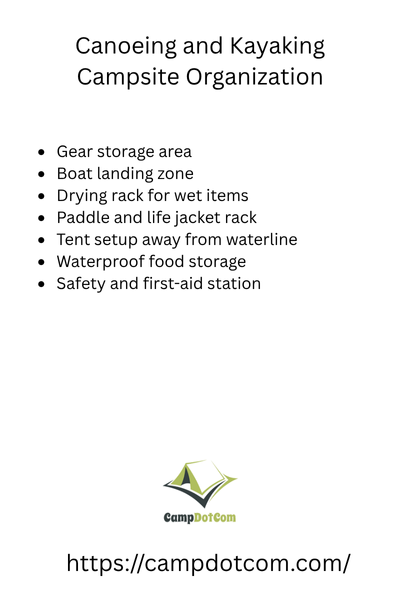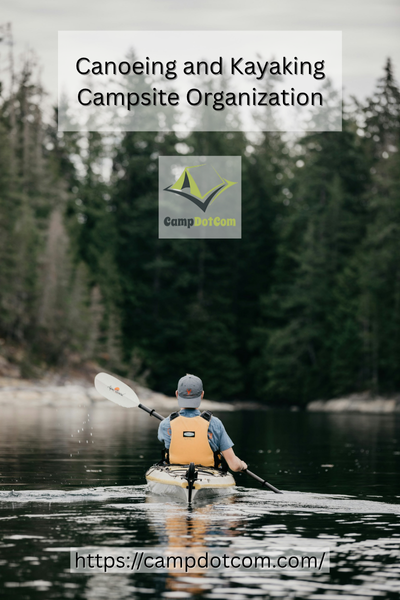If you have ever found yourself ankle deep in soggy gear or wondering where you packed the camp stove, welcome to the wild world of canoeing and kayaking campsite organization. It is one thing to paddle all day and enjoy the water, totally worth it, but it is a whole different game when it is time to unpack at camp.
I learned this the hard way on a three day kayaking trip down the Suwannee River. By night two, my dry bag was anything but dry, I could not find my headlamp, and my tent stakes were apparently off on a solo adventure somewhere else. I sat there, tired and mosquito bitten, swearing I would never do this again. Of course I did, but next time I came prepared.
Let us talk about how you can keep your campsite organized, gear dry, and spirits high.
As an Amazon Associate, I earn from qualifying purchases. Some of the links in this article are affiliate links. This means that, at zero cost to you, I will earn an affiliate commission if you click through the link and finalize a purchase.
Read More About Canoeing and Kayaking Campsite Organization

Start with Smart Packing
Before you even dip a paddle in the water, your canoeing and kayaking campsite organization begins. Think of your boat as a floating closet—but not one you want to fling open and have everything spill out.
Group gear by use such as cooking, sleeping, clothing, and emergency supplies. Then pack them in color coded dry bags. I use blue for sleeping gear, red for first aid and safety stuff, and green for food. It is like adult level Tetris with real life rewards like actually being able to find your matches when the sun goes down.
And don’t forget the balance. You can’t have all your heavy stuff on one end of the canoe unless you’re a big fan of tipping over. (Been there. Cold water. Zero stars.)
More Things to Know About Canoeing and Kayaking Campsite Organization

Keep Gear Accessible (But Not Everywhere)
There’s a fine line between “ready for anything” and “my kayak looks like a yard sale.” You don’t need everything within reach. I usually keep a small deck bag or dry pouch clipped near me with essentials: sunscreen, snacks, phone, bug spray, and a mini first aid kit.
The rest can stay tucked away until you hit camp. When you land, having clearly labeled bags makes it easy to grab what you need without digging through every container like a raccoon at midnight.
Campsite Setup With Flow
Once you’re ashore, canoeing and kayaking campsite organization becomes all about flow. And I’m not talking about river current.
Here’s what works for me: I pick a central zone for cooking and eating, usually close to the fire ring if there is one. Then I set up my tent at least 200 feet away from water (safety first, my friend). My “kitchen” gets its own space, far enough from the tent to keep the food smells away from where I’m sleeping. Bears? Raccoons? I’d rather not have surprise visitors.
My clothesline gets strung up between two trees, and I always hang up wet clothes and gear first. It’s no fun putting on cold socks in the morning. Trust me.
Embrace the Dry Bag System
I can’t overstate how much a good dry bag system saved my sanity. On one trip, my friend used a garbage bag as a waterproof solution. By the time we got to shore, his sleeping bag looked like it had been dunked in a pond—and technically, it had.
Invest in good quality dry bags in different sizes. Bonus tip? Label them with a permanent marker. When you’re dog-tired after paddling for hours, you’ll be glad you don’t have to guess which bag has your camp stove and which one is your underwear.
Don’t Forget Camp Breakdown
Canoeing and kayaking campsite organization does not stop when the stars come out. Before bed, I always do a quick cleanup. Trash bagged and hung or stored in a bear canister, dishes washed, gear tucked under the tarp in case of rain.
When I skip this step, I always regret it in the morning. Nothing ruins coffee like searching for your pot in the dew covered grass.
Take ten minutes to reset before you sleep. Your future self, especially the pre coffee version, will thank you.
Why It’s Worth the Effort
Sure, organizing your gear and setting up camp with some structure takes a bit more effort. But it also means fewer headaches, faster setup, and way more time to actually enjoy where you are. Plus, your gear lasts longer when you treat it right.
And honestly? There’s something kind of satisfying about having your own little system in place, especially when you’re out in the wild where not much is under your control.
Paddle Smart, Camp Smarter
Whether you are out for a weekend or a week, canoeing and kayaking campsite organization can make or break your trip. With a little planning and a few smart habits, you will spend less time searching for things and more time soaking in the views, laughing with your paddle crew, or just relaxing by the fire.
So grab your dry bags, plan your setup, and hit the water. It does not have to be perfect. It just has to work for you. And when it does? That is where the magic really starts.
Happy paddling!
